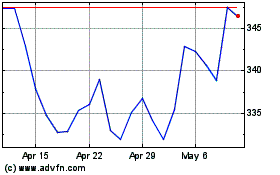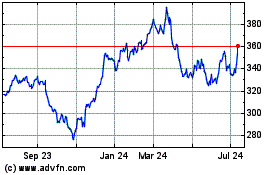By Sarah Nassauer
This article is being republished as part of our daily
reproduction of WSJ.com articles that also appeared in the U.S.
print edition of The Wall Street Journal (August 10, 2019).
When Carol Tomé became chief financial officer at Home Depot
Inc. in 2001 she faced several challenges. Sales were slowing, and
new Chief Executive Robert Nardelli was struggling to change the
home-improvement retailer's strategy and ruffling feathers with
efficiency measures.
Over the next 19 years, Ms. Tomé helped the company return to a
solid footing, successfully navigate the housing crisis and, thus
far, fend off incursions from Amazon.com Inc.
In 2014, she was one of three top executives considered by the
board to succeed Frank Blake as CEO. She didn't get the job, but
decided to stay on as finance chief.
The 62-year-old executive will retire from Home Depot this month
and be succeeded by Richard McPhail, whom Ms. Tomé helped to groom
for the role over many years, she said.
From the back room of a Home Depot store in Lodi, N.J., Ms. Tomé
reflected on her nearly two decades as CFO at the retailer. The
interview has been edited and condensed for readability.
--Sarah Nassauer
WSJ: Home Depot was struggling a bit in those years before the
housing crisis. What was it like to be in your role at the largest
home improvement retailer?
Carol Tomé: We took our focus off of the retail business to
invest in the wholesale distribution business, but there was more
to it than that. There was a cultural revolution happening in the
company in that we had turned what is really a unique management
construct, the inverted pyramid, where we're at the bottom of the
pyramid supporting our associates who take care of our customers.
We had turned that pyramid around and our associates were at the
bottom of the pyramid. So, when Frank Blake became our CEO
beginning in 2007, he turned to me and said, "What should we do
with HD Supply?" And I said, "Sell it. We've got to focus back on
the core."...
We sold HD Supply at a time when we were heading into the worst
recession since the Great Depression. As you know it was led by
housing. It was led by the financial crisis, and we felt it. We
felt it big. Between 2006 and 2009, we lost $13 billion in our
sales, or 25%.
WSJ: Can you talk us through some of the key hard decisions, and
how you felt about them at the time?
Ms. Tomé: We had to close stores. We had to take new stores out
of our store-opening pipeline. We had to exit businesses....When we
closed our Expo business [a chain of high-end home remodeling
stores] Frank and I got in a plane and we flew to Florida, because
we had a number of Expo stores in Florida. We walked into the store
and the associates were there who were losing their jobs. I sat
down and held the hand of the associates who were crying...I'm
like, "It's not your fault. We had a big, bad business model."...I
vowed to myself on that day that I would never allocate capital
again to another store that needed to be closed, because it was
just too hard...[We decided] our economic engine will no longer be
driven by square-footage growth. It will be driven by productivity
and efficiency coming off of effective capital allocation.
WSJ: Today we see other retailers making or thinking about
similar choices. Do you remember back in those days what some of
the debate was around that shift?
Ms. Tomé: The leadership team, we were all on board. We
understood that this was the right thing to do. We had to bring
everybody else along with us...We would put up data...When I
started, there were 75,000 households per home improvement store.
By the 2007, 2008 time frame, 33,000 to 35,000 households per home
improvement store...The market was getting saturated, so you could
show, hey, opening up stores in markets where we are already
present actually is dilutive...We had to talk about it, and talk
about it, and talk about it again. But when we came out of the
recession and we started to show that we could grow, and not only
grow, but outperform our next largest big-box competitor, people
started to believe.
WSJ: What advice do you have for other CFOs that are helping a
company navigate a time of difficulty beyond their control?
Ms. Tomé: I think the best CFOs are business people first, and
finance people second. It's really clearly important to your
effectiveness to understand the business you're supporting. And
that means, for me, when I started, I had to put on an apron and
work in the store. You need to be able to speak the language of the
business, not the language of finance...You have to figure out what
motivates people. Is it career opportunities? Is it career growth?
Hit those emotional sweet spots. Try to be an inspirational leader.
So many finance folks are not very inspirational.
WSJ: What are your thoughts and advice on how to navigate three
very different CEOs? How do you not only stay valuable to the
company, but want to keep doing the job?
Ms. Tomé: I view my role as a partner. I view my role as someone
who should debate. Debate from a point of facts, but debate...But
once the play is called, as long as the play is ethical...I run the
play full out. I'm as loyal as the day is long...When Frank Blake
was getting ready to retire...he had identified three internal
candidates who might follow him, and I was one of those. When Craig
Menear was named CEO, I was thrilled for Craig...But I had to make
some decisions at that point, because typically if you're in line
and you don't get it, well you've got to decide what you're going
to do.
The other person who was being considered was Marvin Ellison
[the current CEO at rival Lowe's Cos.], and he elected to leave our
company...Frank Blake, who I just adore, he gave me a piece of
advice. He said, "Carol, as you think about it, I'd ask that you
think about it through the lens of impact. Where could you have the
biggest impact?" And so I thought long and hard about that. I'm
like, "You know what? I think I could have the biggest impact at
The Home Depot...And it was by far the best decision I've ever
made.
WSJ: If you look into your crystal ball beyond the time you will
be at Home Depot, how do you think Amazon will challenge the home
improvement space?
Ms. Tomé: The difference between us and Amazon is this: We don't
have a moat around our business...But we have a number of barrier
islands, and we're investing in those barrier islands. One would be
our people. Customers come into our store because they need help,
right? "I don't want to burn down my house, and yet I need to
rewire this socket. Could you help me?"...When you think about our
potential contractor customer making 45% of our sales, you know why
they come into our store? They come into our store for a break. We
have free coffee for them. They can use our bathrooms, and they can
chat it up at the Pro desk. That's not an Amazon-like experience.
Amazon is a fantastic, amazing company. But we offer a different
experience, so that's a bit of a barrier island.
Write to Sarah Nassauer at sarah.nassauer@wsj.com
(END) Dow Jones Newswires
August 10, 2019 02:47 ET (06:47 GMT)
Copyright (c) 2019 Dow Jones & Company, Inc.
Home Depot (NYSE:HD)
Historical Stock Chart
From Mar 2024 to Apr 2024

Home Depot (NYSE:HD)
Historical Stock Chart
From Apr 2023 to Apr 2024
